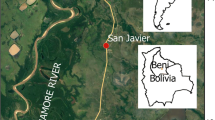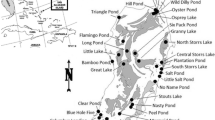Abstract
The growth of metacommunity ecology as a subdiscipline has increased interest in how processes at different spatial scales structure communities. However, there is still a significant knowledge gap with respect to relating the action of niche- and dispersal-assembly mechanisms to observed species distributions across gradients. Surveys of the larval dragonfly community (Odonata: Anisoptera) in 57 lakes and ponds in southeast Michigan were used to evaluate hypotheses about the processes regulating community structure in this system. We considered the roles of both niche- and dispersal-assembly processes in determining patterns of species richness and composition across a habitat gradient involving changes in the extent of habitat permanence, canopy cover, area, and top predator type. We compared observed richness patterns and species distributions in this system to patterns predicted by four general community models: species sorting related to adaptive trade-offs, a developmental constraints hypothesis, dispersal assembly, and a neutral community assemblage. Our results supported neither the developmental constraints nor the neutral-assemblage models. Observed patterns of richness and species distributions were consistent with patterns expected when adaptive tradeoffs and dispersal-assembly mechanisms affect community structure. Adaptive trade-offs appeared to be important in limiting the distributions of species which segregate across the habitat gradient. However, dispersal was important in shaping the distributions of species that utilize habitats with a broad range of hydroperiods and alternative top predator types. Our results also suggest that the relative importance of these mechanisms may change across this habitat gradient and that a metacommunity perspective which incorporates both niche- and dispersal-assembly processes is necessary to understand how communities are organized.


Similar content being viewed by others
References
Bell G (2001) Ecology—neutral macroecology. Science 293:2413–2418
Bernath B, Szedenics G, Molnar G, Kriska G, Horvath G (2001) Visual ecological impact of “shiny black anthropogenic products” on aquatic insects: oil reservoirs and plastic sheets as polarized traps for insects associated with water. Arch Nat Conserv Landsc Res 40:89–109
Bernath B, Szedenics G, Wildermuth H, Horvath G (2002) How can dragonflies discern bright and dark waters from a distance? The degree of polarisation of reflected light as a possible cue for dragonfly habitat selection. Freshw Biol 47:1707–1719
Chase JM (2003) Community assembly: when should history matter? Oecologia 136:489–498
Collins SL (2000) Disturbance frequency and community stability in native tallgrass prairie. Am Nat 155:311–325
Colwell RK, Coddington JA (1994) Estimating terrestrial biodiversity through extrapolation. Philos Trans R Soc Lond B Biol Sci 345:101–118
Connell JH (1978) Diversity in tropical rain forests and coral reefs—high diversity of trees and corals is maintained only in a non-equilibrium state. Science 199:1302–1310
Cornell HV, Lawton JH (1992) Species interactions, local and regional processes, and limits to the richness of ecological communities—a theoretical perspective. J Anim Ecol 61:1–12
Cottenie K (2005) Integrating environmental and spatial processes in ecological community dynamics. Ecol Lett 8:1175–1182
Cottenie K, De Meester L (2004) Metacommunity structure: synergy of biotic interactions as selective agents and dispersal as fuel. Ecology 85:114–119
Cottenie K, Nuytten N, Michels E, De Meester L (2001) Zooplankton community structure and environmental conditions in a set of interconnected ponds. Hydrobiologia 442:339–350
Driscoll DA (2008) The frequency of metapopulations, metacommunities and nestedness in a fragmented landscape. Oikos 117:297–309
Ellis AM, Lounibos LP, Holyoak M (2006) Evaluating the long-term metacommunity dynamics of tree hole mosquitoes. Ecology 87:2582–2590
Friedenberg NA (2003) Determinism in a transient assemblage: the roles of dispersal and local competition. Am Nat 162:586–596
Gilbert B, Lechowicz MJ (2004) Neutrality, niches, and dispersal in a temperate forest understory. Proc Natl Acad Sci USA 101:7651–7656
Gotelli NJ, Entsminger GL (2001) EcoSim: null models software for ecology, 7.0 edn. Acquired Intelligence Inc. & Kesey-Bear, Jericho (see http://homepages.together.net/~gentsmin/ecosim.htm, last accessed 4 Sept 2008)
Gotthard K (2000) Increased risk of predation as a cost of high growth rate: an experimental test in a butterfly. J Anim Ecol 69:896–902
Holt RD (1997) On the evolutionary stability of sink populations. Evol Ecol 11:723–731
Holyoak M, Leibold MA, Holt RD (2005) Metacommunities: spatial dynamics and ecological communities. University of Chicago Press, Chicago
Hubbell SP (2001) The unified neutral theory of biodiversity and biogeography. Princeton University Press, Princeton
Jackson DA (1993) Stopping rules in principal components-analysis—a comparison of heuristic and statistical approaches. Ecology 74:2204–2214
Johansson F, Suhling F (2004) Behaviour and growth of dragonfly larvae along a permanent to temporary water habitat gradient. Ecol Entomol 29:196–202
Johansson F, Englund G, Brodin T, Gardfjell H (2006) Species abundance models and patterns in dragonfly communities: effects of fish predators. Oikos 114:27–36
Kneitel JM, Miller TE (2003) Dispersal rates affect species composition in metacommunities of Sarracenia purpurea inquilines. Am Nat 162:165–171
Lehman CL, Tilman D (1997) Competition in spatial habitats. In: Tilman D, Kareiva P (eds) Spatial ecology: the role of space in population dynamics and interspecific interactions. Princeton University Press, Princeton, pp 185–203
Leibold MA, Mikkelson GM (2002) Coherence, species turnover, and boundary clumping: elements of meta-community structure. Oikos 97:237–250
Leibold MA et al (2004) The metacommunity concept: a framework for multi-scale community ecology. Ecol Lett 7:601–613
Loreau M, Mouquet N (1999) Immigration and the maintenance of local species diversity. Am Nat 154:427–440
McCauley SJ (2005) Species distributions in anisopteran odonates: effects of local and regional processes. Dissertation, University of Michigan, Ann Arbor
McCauley SJ (2007) The role of local and regional processes in structuring larval dragonfly distributions across habitat gradients. Oikos 116:121–133
McCauley SJ (2008) Slow, fast and in between: habitat distribution and behaviour of larvae in nine species of libellulid dragonfly. Freshw Biol 53:253–263
McPeek MA (1989) Differential dispersal tendencies among enallagma damselflies (odonata) inhabiting different habitats. Oikos 56:187–195
McPeek MA (2004) The growth/predation risk trade-off: So what is the mechanism? Am Nat 163:E88–E111
O’Brien M (2008) Michigan Odonata Survey (online): Odonata known from Michigan. http://insects.ummz.lsa.umich.edu/MICHODO/michodolist.html, last accessed 4 Sept 2008
Patterson BD, Atmar W (1986) Nested subsets and the structure of insular mammalian faunas and archipelagoes. Biol J Linn Soc 28:65–82
Resetarits WJ Jr, Binckley CA, Chalcraft DR (2005) Habitat selection, species interactions, and processes of community assembly in complex landscapes: a metacommunity perspective. In: Holyoak M, Leibold MA, Holt RD (eds) Metacommunities spatial dynamics and ecological communities. The University of Chicago Press, Chicago, pp 374–398
Schneider D, Frost T (1996) Habitat duration and community structure in temporary ponds. J North Am Benthol Soc 15:64–86
Shmida A, Wilson MV (1985) Biological determinants of species-diversity. J Biogeogr 12:1–20
Shurin JB (2001) Interactive effects of predation and dispersal on zooplankton communities. Ecology 82:3404–3416
Skelly DK (1995) A behavioral trade-off and its consequences for the distribution of pseudacris treefrog larvae. Ecology 76:150–164
Skelly DK (1996) Pond drying, predators, and the distribution of Pseudacris tadpoles. Copeia 3:599–605
Skelly DK, Werner EE, Cortwright SA (1999) Long-term distributional dynamics of a Michigan amphibian assemblage. Ecology 80:2326–2337
Skelly DK, Bolden SR, Holland MP, Freidenburg LK, Freidenfelds NA, Malcolm TR (2006) Urbanization and disease in amphibians. In: S Collinge, C Ray (eds) Ecology of disease: community context and pathogen dynamics. Oxford University Press, Oxford
Stoks R, McPeek MA (2003) Predators and life histories shape Lestes damselfly assemblages along a freshwater habitat gradient. Ecology 84:1576–1587
Tilman D (1994) Competition and biodiversity in spatially structured habitats. Ecology 75:2–16
Tilman D (1997) Community invasibility, recruitment limitation, and grassland biodiversity. Ecology 78:81–92
Tofts R, Silvertown J (2002) Community assembly from the local species pool: an experimental study using congeneric species pairs. J Ecol 90:385–393
Urban MC (2004) Disturbance heterogeneity determines freshwater metacommunity structure. Ecology 85:2971–2978
Vandvik V, Goldberg DE (2006) Sources of diversity in a grassland metacommunity: quantifying the contribution of dispersal to species richness. Am Nat 168:157–167
Vanschoenwinkel B, De Vries C, Seaman M, Brendonck L (2007) The role of metacommunity processes in shaping invertebrate rock pool communities along a dispersal gradient. Oikos 116:1255–1266
Walker EM, Corbet PS (1978) The Odonata of Canada and Alaska. University of Toronto Press, Toronto
Wellborn GA, Skelly DK, Werner EE (1996) Mechanisms creating community structure across a freshwater habitat gradient. Annu Rev Ecol Syst 27:337–363
Werner EE, Anholt BR (1993) Ecological consequences of the trade-off between growth and mortality-rates mediated by foraging activity. Am Nat 142:242–272
Werner EE, Skelly DK, Relyea RA, Yurewicz KL (2007) Amphibian species richness across environmental gradients. Oikos 116:1697–1712
Wissinger SA, Whiteman HH, Sparks GB, Rouse GL, Brown WS (1999) Foraging trade-offs along a predator-permanence gradient in subalpine wetlands. Ecology 80:2102–2116
Woodward BD (1983) Predator–prey interactions and breeding-pond use of temporary-pond species in a desert anuran community. Ecology 64:1549–1555
Wright JP, Flecker AS, Jones CG (2003) Local vs. landscape controls on plant species richness in beaver meadows. Ecology 84:3162–3173
Acknowledgments
Many people provided useful comments on this manuscript at various stages in its development, including M. Benard, T. Brodin, J. Middlemas-Brown, D. Dritz, P. Epanchin, S. Fogarty, M. Fraker, D. Goldberg, B. Hazlett, M. Holyoak, S. Lawler, B. Luttbeg, T. Morgan, J. Saltz, S. Schneider, A. Sih, E. Silverman, W. White, and A. Zellmer. Too many researchers to name individually helped with sampling, and we are grateful to all of them. Access to the ESGR was provided by the Museum of Zoology and R. Nussbaum. J. Bolgos provided logistical support. This research was funded by NSF grants: DEB-9727014 to E. Werner, D. Skelly, R. Relyea, and K. Yurewicz, and DEB-0089809 to E. Werner and S. Peacor. S. McCauley received funding to sample water bodies off the ESGR from the Michigan Natural Heritage program funded by citizen contributions to the State of Michigan’s Nongame Wildlife Fund (NH01-034), and from a Sigma Xi Grants-in-Aid of Research award. S. McCauley was supported by a University of Michigan Rackham Predoctoral Fellowship during the initial writing of this manuscript, and by a Center for Population Biology Postdoctoral Research Fellowship during the revision of this manuscript. This research complies with the current laws of the United States.
Author information
Authors and Affiliations
Corresponding author
Additional information
Communicated by Steven Kohler.
Electronic supplementary material
Below is the link to the electronic supplementary material.
Rights and permissions
About this article
Cite this article
McCauley, S.J., Davis, C.J., Relyea, R.A. et al. Metacommunity patterns in larval odonates. Oecologia 158, 329–342 (2008). https://doi.org/10.1007/s00442-008-1141-8
Received:
Accepted:
Published:
Issue Date:
DOI: https://doi.org/10.1007/s00442-008-1141-8




